Silvio Griccioli, Abbazia di Sant’Eugenio, Munistero, Siena, by 1897; Dan Fellows Platt (1873–1938), Englewood, N.J., by 1912; Hannah D. and Louis M. Rabinowitz (1887–1957), Sands Point, Long Island, N.Y., by 1945
The panel support, of a vertical grain, was thinned to a depth ranging from 1.5 to 2.3 centimeters and mounted on a later auxiliary support 1.5 centimeters thick. It comprises three planks, averaging 16, 42.5, and 16 centimeters in width, originally reinforced by battens applied to the reverse and engaged frame moldings on the obverse, all of which are missing. The seams between the planks are now open, the gap on the left ranging from 2 to 6 millimeters and on the right averaging 2 millimeters, although widening to 5 millimeters near the upper edge due to losses from insect damage. A prominent split runs the full height of the central plank, beginning at the bottom edge just to the left of center and rising on a slight diagonal toward the left. A minor split has opened parallel and to the right of this, occasioned by a knot in the panel at the level of the Virgin’s shoulder. Extensive insect damage has been revealed beneath the missing engaged frame moldings around the full periphery and beneath missing linen, gesso, and preparatory layers along the panel seams, especially that on the left. The gilding and paint surfaces have been severely abraded, exposing large areas of gesso preparation and, in the flesh tones, verdaccio underpaint. Areas of complete loss—to the right of the throne, through the Virgin’s left elbow, and along the right portion of the throne platform—were enlarged and cleaned to the level of the wood support by Andrew Petryn in 1968, a treatment that also left large patterns of exposed gesso visible through the broad craquelure of the Virgin’s blue robe (fig. 1). Many of these were reduced with tratteggio inpainting by Irma Passeri in a treatment of 2006–7, but the larger complete losses have necessarily been left open.1 The two saints painted alongside the throne at the left are reasonably well preserved; those on the right have effectively been obliterated.
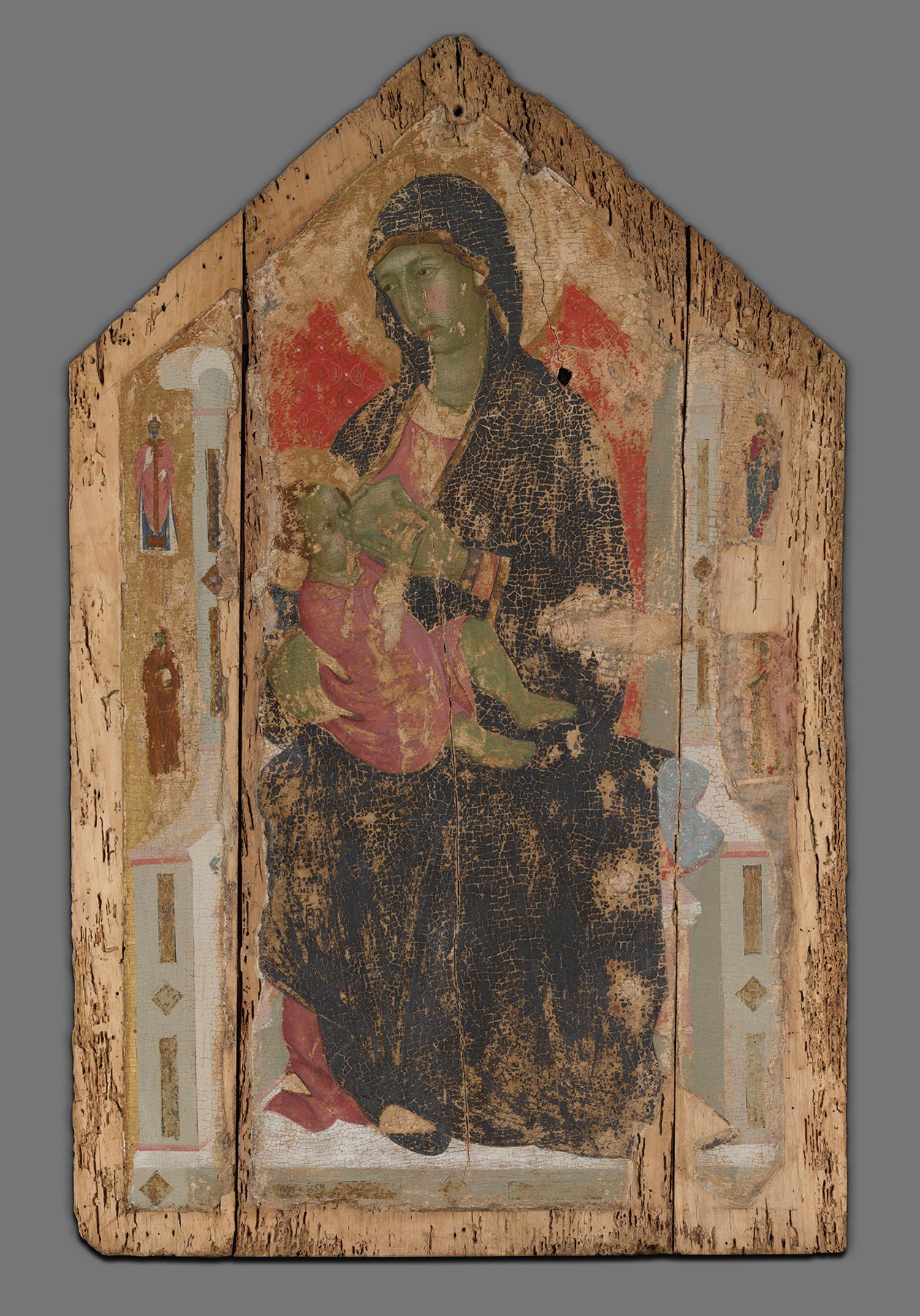
The Virgin and Child Enthroned with Four Saints was brought to the attention of scholars by Bernard Berenson in 1897, when he listed it in the first edition of his Central Italian Painters of the Renaissance as the work of Duccio.2 Its inclusion in the great 1904 exhibition of Sienese art, in Siena, as “maniera di Duccio” brought it further notoriety,3 and it has figured prominently in most general studies of early Sienese painting since. Except for Berenson—who made no distinction between the work of Duccio and that of his followers in the first or second editions of his lists and who identified no Ducciesque painters there as individual personalities—no scholar has ventured to associate the painting directly with Duccio, and opinions regarding its authorship have varied widely. The first scholar to investigate systematically the spread of Duccio’s influence was Curt Weigelt, who rejected an attribution for the Yale painting to Duccio, calling it instead a possible early work by Segna di Bonaventura, the more esteemed of only two overtly Ducciesque painters then recognized by name—Ugolino di Nerio being the other.4 F. Mason Perkins did not advance a specific attribution for the painting, although he felt certain that it must date from the first decade of the fourteenth century, and he did not hesitate to pronounce it “undoubtedly the most important Ducciesque painting at present in America” once it had entered the Dan Fellows Platt collection.5 He did suggest that a fragmentary head of the Magdalen acquired in 1915 by the Museum of Fine Arts, Boston (fig. 2), with an attribution to Segna, might be a later work by the same hand6—possibly the only two surviving works by a gifted but otherwise unknown artist. Raimond van Marle recognized the evident community of style linking the Platt and Boston paintings but also how distinct they were from Segna’s signed or securely attributed works.7 Weigelt, returning to the argument in 1930, explicitly rejected any association between the Boston and Platt paintings.8
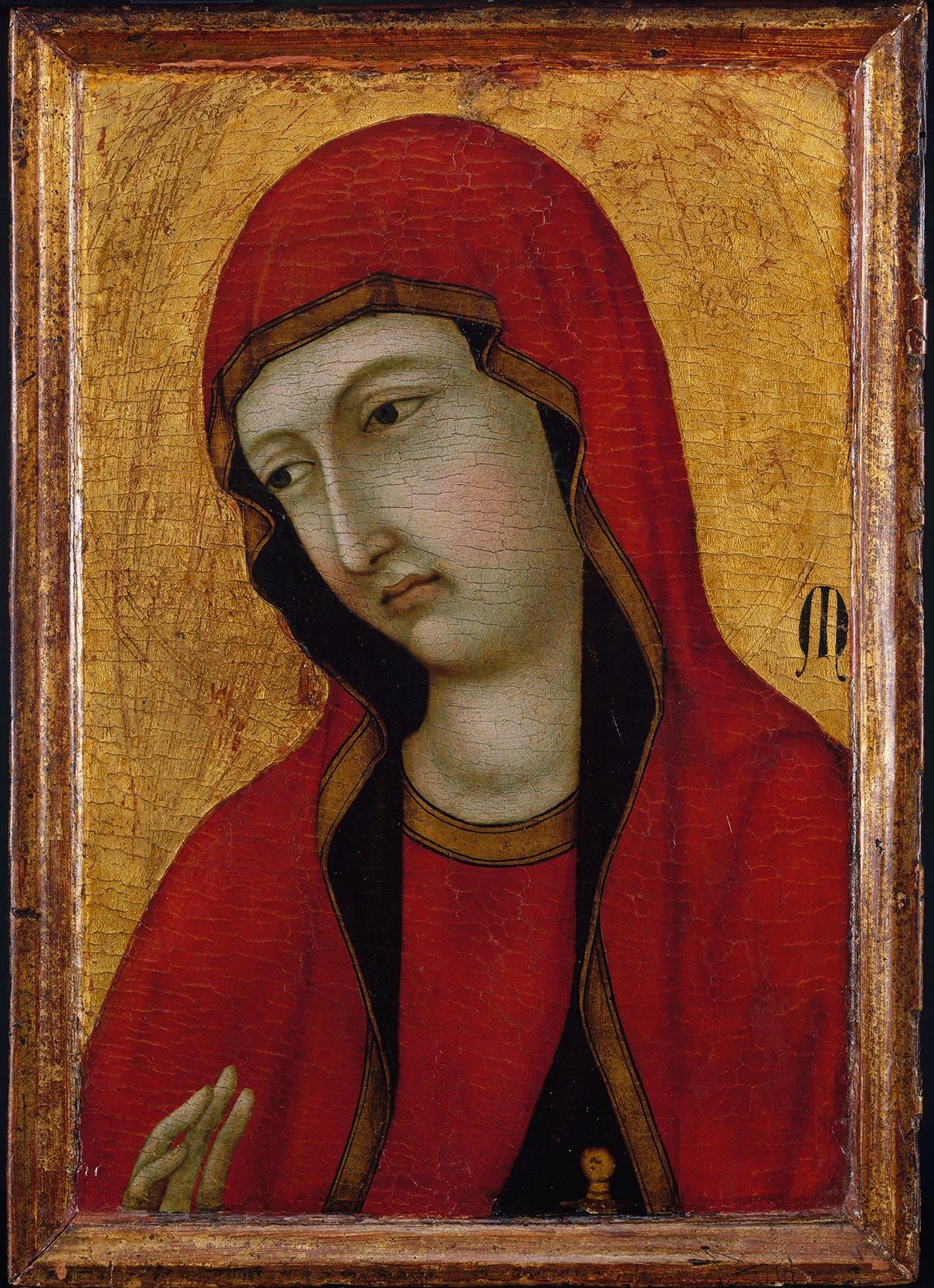
All discussion of the Virgin and Child Enthroned with Four Saints published after 1930 has been heavily inflected by the observations of George Harold Edgell, who was inclined to accept van Marle’s estimation of the painting but noted that its subject, the Madonna nursing the Christ Child, became common in Sienese painting only after Ambrogio Lorenzetti’s prototype (fig. 3) and that, therefore, “the work is not so early as it seems. It is quite possible that the artist was a close follower of Segna, working in the old manner, but actually a contemporary of the younger Lorenzetti and accustomed to the popularization of the motive. Though the painting looks earlier, there is nothing to prevent its having been done as late as 1340 or even 1345.”9 From this point forward, the problem of the painting’s attribution was no longer deemed consequential, as it was universally considered a work of 1330 or later, and the task of distinguishing among the followers of Segna di Bonaventura (the only Ducciesque painters known to have been active at so late a date) was scarcely worth the effort. Recording the picture as Segna or his circle,10 Niccolò di Segna,11 or the “Master of the Grosseto Madonna”12 was tantamount to looking at little more than its subject. Even that limited focus of attention evaporated following the drastic cleaning of the painting at Yale in 1968 (see fig. 1), after which the Virgin and Child Enthroned with Four Saints effectively disappeared from the literature of Sienese trecento painting. Luciano Bellosi saw it in storage at the Gallery in 1987 and expressed his opinion that it was the work of Segna di Bonaventura, but this opinion did not appear in print until 2003. In his extended introduction to the exhibition catalogue Duccio: Alle origini della pittura senese, Bellosi suggested that Duccio’s influence on his younger contemporaries in Siena was immediate and overwhelming, citing as evidence, among other works, the Yale Virgin and Child Enthroned, which he assigned to Segna as possibly his earliest surviving effort, painted still within the last decade of the thirteenth century.13
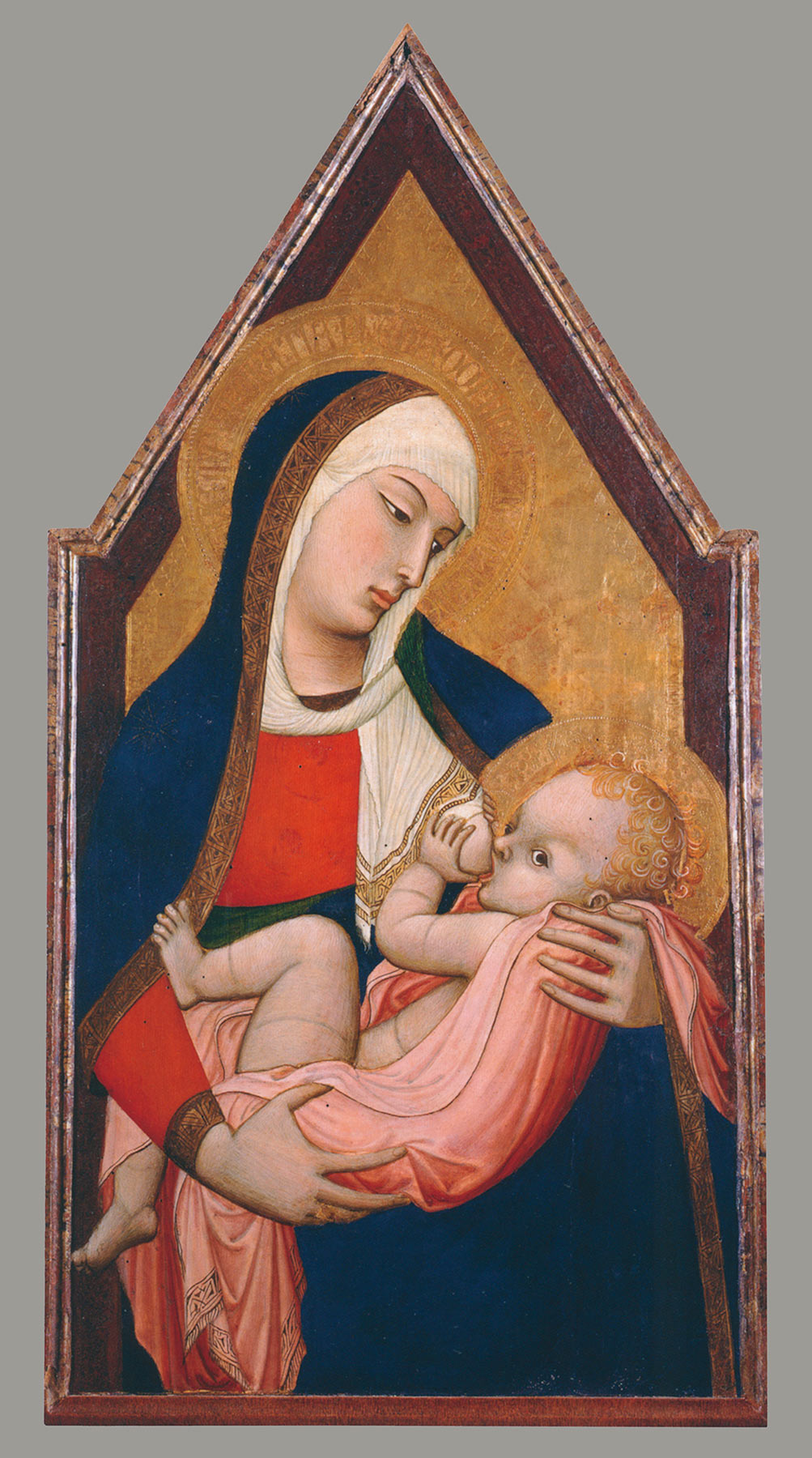
A meaningful discussion of the authorship of the Virgin and Child Enthroned with Four Saints depends, in the first instance, on estimating its likely date of execution. Doing so on the basis of iconographic evidence is scarcely reliable. Not only is it unclear that Ambrogio Lorenzetti’s Madonna del Latte (see fig. 3) is the earliest example of its type, as opposed to the earliest surviving example, but also the novelty of Ambrogio’s painting lies not in its subject but in the manner of its presentation, portraying the Virgin half-length and emphasizing the realistic torsions of a very lively Christ Child. Other fourteenth-century Sienese versions of the Madonna del Latte theme combine the naturalism of Ambrogio’s vision with the motif of the Virgin of Humility, showing the Mother and Child seated informally on the ground. As James Stubblebine observed (without drawing the logical consequences from his observation), the specific iconography of the Yale panel—the Madonna Lactans enthroned—is a thirteenth-century type that does not recur in the fourteenth century. On this basis alone, it should be conceded that a date for the Yale painting later than the thirteenth century or, at most, in the first decade of the fourteenth century is unlikely. Combined with the archaic motif of diminutive saints stacked against the gold ground to either side of the Virgin’s throne and the frontal presentation and marble architecture of the throne itself, a date for the painting within ten years on either side of 1300 seems all but certain.
Reinforcing this impression is the fact that all, or nearly all, Virgins painted in Siena in the thirteenth century were provided with a red cap covering their hair, which was replaced sometime around the year 1300 with a preference for a white veil that quickly became normative for representations of the Mother of God. The Yale Virgin, to all appearances, is portrayed with neither the cap nor the veil, which would be all but unique among Sienese paintings of this period. There is, however, some evidence that in its original state the Virgin in the Yale painting was provided with a white veil. The unpainted band crossing the top of the Virgin’s pink dress below her throat shows traces of underdrawing delineating folds of fabric that can best be interpreted as the ends of such a veil crossing below her outer robe at that point. The veil itself, therefore, was probably painted over the blue lining of her cowl and must have been destroyed by the abrasive cleaning of the paint surface. Once a white veil became the accepted standard for representations of the Virgin and Child, the area of the picture surface it was to occupy was left in reserve so that the white could be painted directly on top of the white gesso ground, and no expensive blue pigment would be wasted by being covered over. That the Yale Virgin does not follow this practice implies a date for it in a transitional moment, before the white veil became an established motif, presumably within the first decade of the fourteenth century. The Master of Città di Castello, for example, in his Virgin and Child formerly in the Museo dell’Opera del Duomo in Siena14 (now reunited with the lateral panels of the same altarpiece in the Pinacoteca Nazionale there15), persuasively dated around or shortly before 1307 by Alessandro Bagnoli, painted a diaphanous white veil on top of the blue of the Virgin’s robe, as he did in two later Virgins in Copenhagen (see Master of Città di Castello, Saint John the Baptist, fig. 3) and Siena.16 The practice is otherwise uncommon.
While it is likely therefore to be true, as Bellosi contends, that the Yale Virgin and Child Enthroned with Four Saints is a highly precocious work of art, it is less certain that it can be ascribed to one of Duccio’s earliest followers, least of all to Segna di Bonaventura. Attributing the Yale painting to Segna seemed more promising when its earlier restorations had given it an artificially linear appearance (fig. 4). Comparison of any of the forms in the painting as it appears today to those in any signed or securely attributed painting by Segna (see Master of the Gondi Maestà, Virgin and Child, fig. 3) reveals a conceptual gulf not bridgeable by its supposed identification as the artist’s earliest effort. Segna, for example, employs a system of arranging drapery folds that can best be described as crystalline or prismatic, with sharp-angled twists and breaks recalling the traditional decorative patterns of his duecento predecessors. The draperies in the Yale painting, on the other hand, swell and undulate in gentle curves; the hems are foreshortened convincingly where they ripple and turn back on themselves, in the manner introduced by Duccio and otherwise mastered only by the most accomplished of Duccio’s younger followers. The heads of Segna’s figures are smaller in proportion to their bodies, longer and narrower in shape, and harder in drawing than the heads in the Yale painting, which more closely resemble, in all respects, the same features in early works by Ugolino di Nerio, particularly paintings such as the Boston Magdalen (see fig. 2), as had indeed been recognized as long ago as 1920. Segna projects hands, arms, and shoulders flat against the picture surface, working as much as possible parallel to the picture plane, whereas the spatial devices, effects of modeling, and narrative gestures incorporated in the Yale painting recall, even more than they do the Magdalen fragment in Boston, the sources of the latter painting within Duccio’s own workshop output.
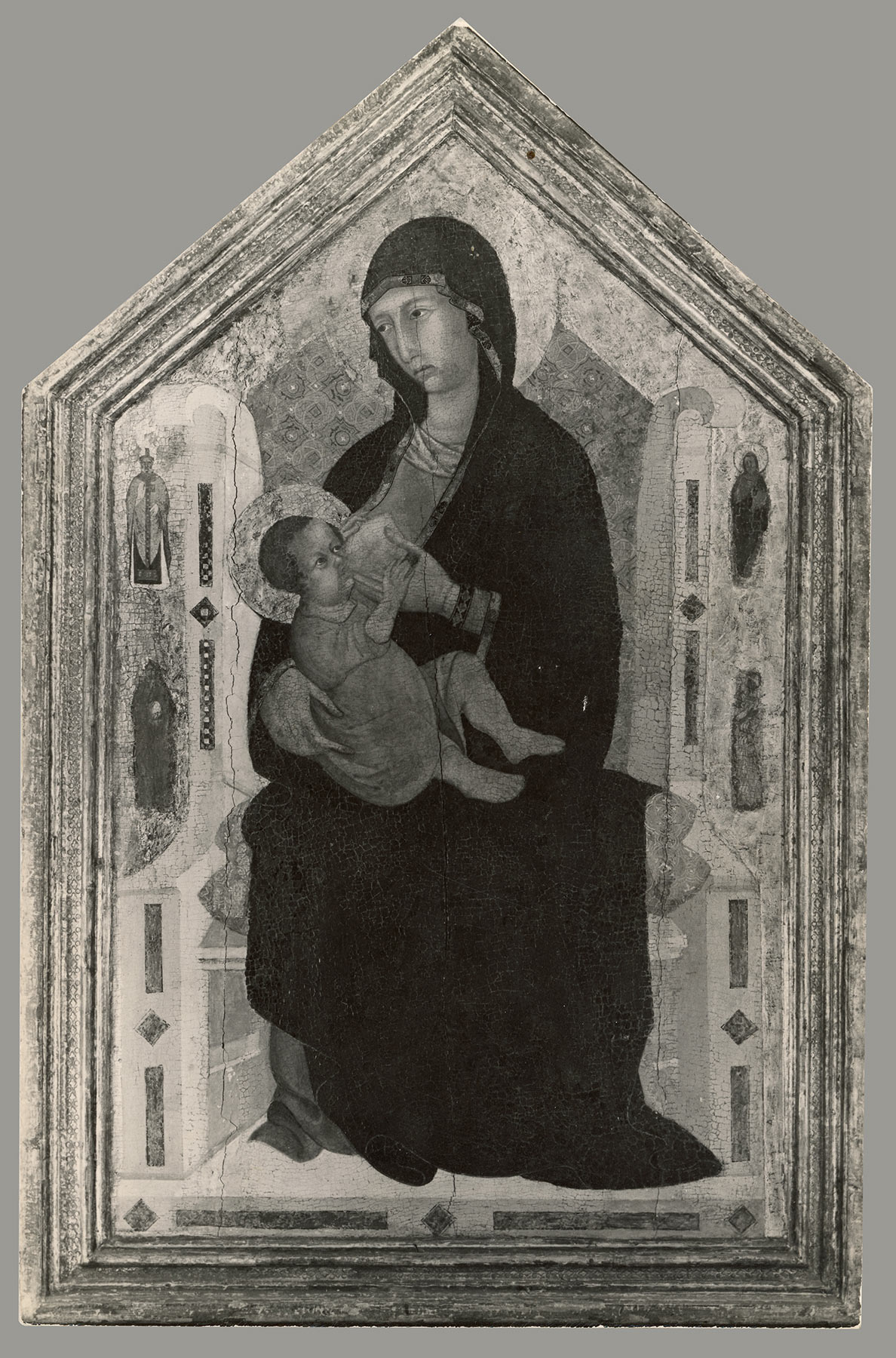
Two paintings among those commonly acknowledged in modern scholarship as the work of Duccio relate more closely than any others to the Yale Virgin and Child Enthroned with Four Saints: the center panel of Polyptych 28 in the Pinacoteca Nazionale, Siena, and the Virgin and Child with Angels in the Galleria Nazionale dell’Umbria, Perugia (fig. 5). It might be reasonable to suppose either that the Yale painting was executed close in date to these two—a date that is not independently documentable but that is by general consensus fixed at ca. 1300–1305—or that it was painted shortly after this date, by an artist who had emerged from Duccio’s studio at about that time. Both possibilities may be supported by the fact that the Yale painting also reflects the spatial and compositional conceits, though not the figure types or proportions, of such earlier paintings by Duccio as the Hampton Court triptych,17 while it betrays no awareness of the later innovations of that master. Above all, it bears no evidence of familiarity with the principal figures of the Siena Cathedral Maestà of 1308–11, a painting that left its mark on all artists in Siena for nearly two full centuries after its completion. Only the absence of chrysography enlivening the surface of the Virgin’s blue robe may be said to relate the figures of the Yale painting to those in works from the second decade of the fourteenth century or later, but it is impossible to be categorically certain that the Yale painting never had mordant gilt decoration of this kind on its presently damaged surface. It cannot be overstated that the extent and severity of the abrasions suffered by this painting over the years render unlikely the possibility of arriving at a firm, incontestable attribution for it. To an unusual degree, the problem of an attribution in this case can be formulated as a function of dating. The earlier (that is, closer to 1300) one is inclined to date the painting, the more one is forced inevitably to consider it a product of Duccio’s own workshop. As its dating is permitted to slip forward toward 1310, the possibility increases of seeing in it the work of Duccio’s most gifted follower, Ugolino di Nerio, who seems to have emerged from his master’s studio at precisely that moment.
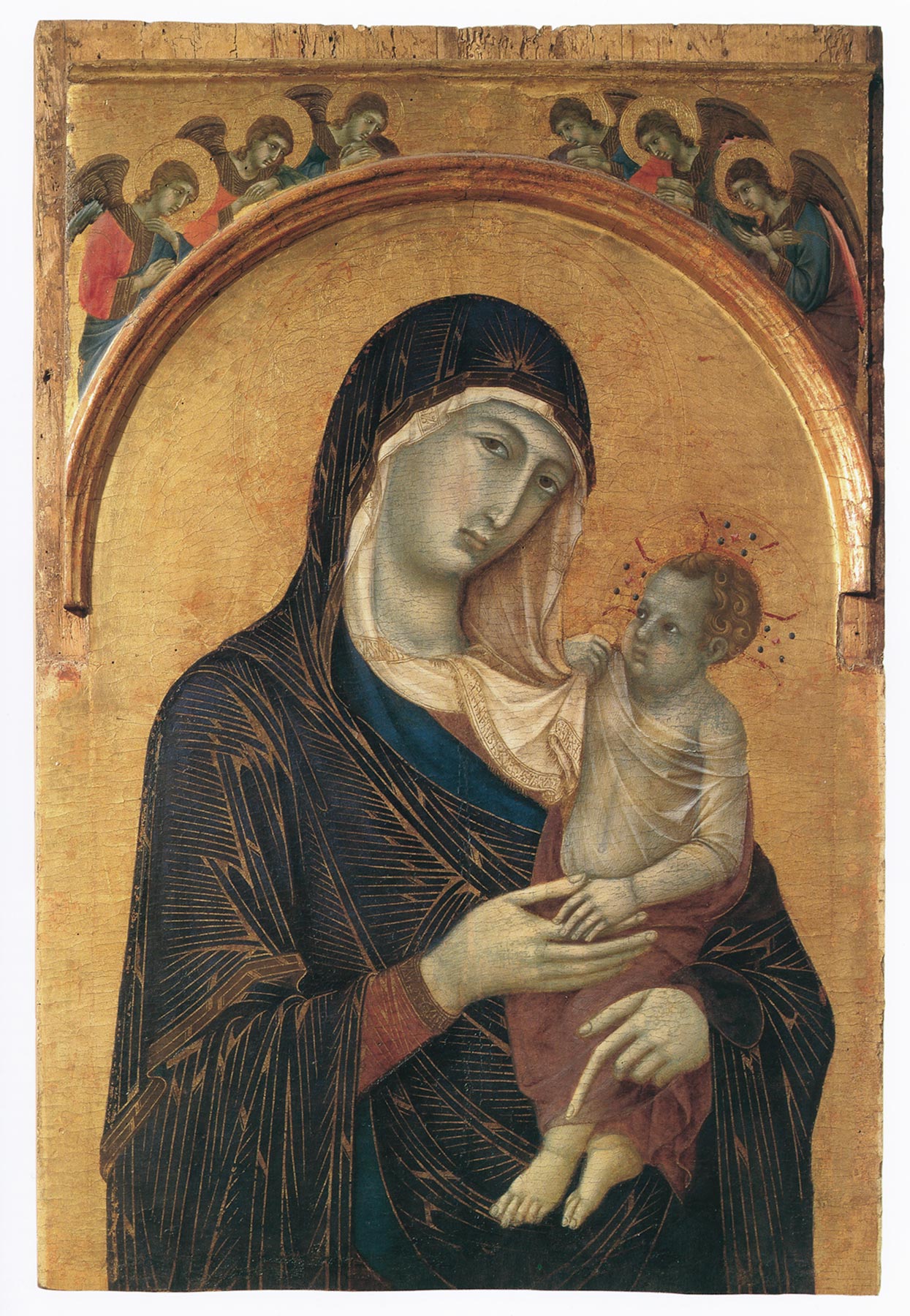
Evidence of a substantial engaged frame secured to the border of the panel along all sides suggests that the Yale Virgin and Child Enthroned with Four Saints was intended from the first to function as a freestanding object, not as a part of a larger multipanel complex. Although it is considerably smaller in size, its composition varies little from those of a number of single-panel altarpieces painted by Sienese artists in the last two decades of the thirteenth century and the first decade of the fourteenth century, including the eponymous works by the Badia a Isola Master and the Master of Città di Castello; severely damaged works related to the latter of these two painters in the National Gallery, London, and the National Gallery of Art, Washington, D.C.;18 and, supposedly, Duccio’s lost Maestà painted in 1302 for the Palazzo Pubblico in Siena. Presumably, the identities of the diminutive saints painted alongside the Yale Virgin’s throne might once have aided in more narrowly circumscribing a function and possibly a provenance for the painting, but in their present condition, only one of these, at the lower left, is positively identifiable: Saint Mary Magdalen. Charles Seymour, Jr., proposed identifying the bishop saint above this figure as Saint Ambrose, interpreting the object held in his hand as a flagellum; this is possible.19 Less certain are his tentative proposals to read the nearly obliterated figures on the right as Saints James the Lesser and Mary of Egypt. The presence of two female saints may imply an origin for the painting in a female monastic establishment. —LK
Published References
Berenson, Bernard. The Central Italian Painters of the Renaissance. New York: G. P. Putnam’s Sons, 1897., 140; Heywood, William, and Lucy Olcott. Guide to Siena: History and Art. Siena: E. Torrini, 1903., 341–42; Ricci, Corrado. Mostra dell’antica arte senese, Aprile–Agosto 1904: Catalogo generale illustrato. Exh. cat. Siena: Sordomuti di Lazzeri, 1904., 308, no. 36; Berenson, Bernard. The Central Italian Painters of the Renaissance. 2nd rev. ed. New York: G. P. Putnam’s Sons, 1909., 163; Weigelt, Curt. Duccio di Buoninsegna: Studien zur Geschichte der frühsienesischen Tafelmalerei. Leipzig, Germany: K. W. Hiersemann, 1911., 190n1; Perkins, F. Mason. “Appunti sulla mostra ducciana a Siena.” Rassegna d’arte antica e moderna 13 (1913): 35–40., 38–39; Perkins, F. Mason. “Some Sienese Paintings in American Collections: Part One.” Art in America 8, no. 5 (August 1920): 195–210., 199, 201; van Marle, Raimond. The Development of the Italian Schools of Painting. Vol. 2. The Hague: M. Nijhoff, 1924., 142–43; Weigelt, Curt. Sienese Painting of the Trecento. New York: Hacker, 1930., 73, 96; Berenson, Bernard. Italian Pictures of the Renaissance: A List of the Principal Artists and Their Works with an Index of Places. Oxford: Clarendon, 1932., 523; Edgell, George Harold. A History of Sienese Painting. New York: Dial, 1932., 64; Venturi, Lionello. The Rabinowitz Collection. New York: Twin Editions, 1945., 7, 11, pl. 111; Meiss, Millard. Painting in Florence and Siena after the Black Death: The Arts, Religion, and Society in the Mid-Fourteenth Century. Princeton, N.J.: Princeton University Press, 1951., 146n58; “Recent Gifts and Purchases: February 22–December 31, 1959.” Yale University Art Gallery Bulletin 26, no. 1 (December 1960): 52–58., 54; Seymour, Charles, Jr. The Rabinowitz Collection of European Paintings. New Haven: Yale University Art Gallery, 1961., 7, 10–11, 55; Berenson, Bernard. Italian Pictures of the Renaissance, A List of the Principal Artists and Their Works with an Index of Places: Central Italian and North Italian Schools. 3 vols. London: Phaidon, 1968., 1:393; Seymour, Charles, Jr. Early Italian Paintings in the Yale University Art Gallery. New Haven: Yale University Art Gallery, 1970., 87–89, no. 62; Fredericksen, Burton B., and Federico Zeri. Census of Pre-Nineteenth-Century Italian Paintings in North American Public Collections. Cambridge, Mass.: Harvard University Press, 1972., 601; Gloria Kury Keach, in Seymour, Charles, Jr., et al. Italian Primitives: The Case History of a Collection and Its Conservation. Exh. cat. New Haven: Yale University Art Gallery, 1972., 38–39, no. 29, figs. 29a–b; Stubblebine, James. Duccio di Buoninsegna and His School. Princeton, N.J.: Princeton University Press, 1979., 1:97, 154, 172, 2: fig. 506; Mazzoni, Gianni. Quadri antichi del novecento. Vicenza: Neri Pozza, 2001., 101–4; Bellosi, Luciano. “Il percorso di Duccio.” In Duccio: Alle origini della pittura senese, ed. Alessandro Bagnoli et al., 117–45. Exh. cat. Cinisello Balsamo, Milan: Silvana, 2003., 131; Kanter, Laurence. “Some Early Sienese Paintings: Cleaned, Uncleaned, Restored, Unrestored; What Have We Learned?” Yale University Art Gallery Bulletin (2010): 46–65., 46–59, 63–65; Aronson, Mark, Ian McClure, and Irma Passeri. “The Art of Conservation: IX, The History of Painting Conservation at the Yale University Art Gallery.” Burlington Magazine 159, no. 1367 (2017): 122–31., 126–27
Notes
-
For an account of this treatment, see Aronson, Mark, Ian McClure, and Irma Passeri. “The Art of Conservation: IX, The History of Painting Conservation at the Yale University Art Gallery.” Burlington Magazine 159, no. 1367 (2017): 122–31., 126–27. ↩︎
-
Berenson, Bernard. The Central Italian Painters of the Renaissance. New York: G. P. Putnam’s Sons, 1897., 140. ↩︎
-
Ricci, Corrado. Mostra dell’antica arte senese, Aprile–Agosto 1904: Catalogo generale illustrato. Exh. cat. Siena: Sordomuti di Lazzeri, 1904., 308, no. 36. ↩︎
-
Weigelt, Curt. Duccio di Buoninsegna: Studien zur Geschichte der frühsienesischen Tafelmalerei. Leipzig, Germany: K. W. Hiersemann, 1911., 190n1. ↩︎
-
Perkins, F. Mason. “Appunti sulla mostra ducciana a Siena.” Rassegna d’arte antica e moderna 13 (1913): 35–40., 38–39; and Perkins, F. Mason. “Some Sienese Paintings in American Collections: Part One.” Art in America 8, no. 5 (August 1920): 195–210., 199. ↩︎
-
Perkins, F. Mason. “Some Sienese Paintings in American Collections: Part One.” Art in America 8, no. 5 (August 1920): 195–210., 199. ↩︎
-
van Marle, Raimond. The Development of the Italian Schools of Painting. Vol. 2. The Hague: M. Nijhoff, 1924., 143. ↩︎
-
Weigelt, Curt. Sienese Painting of the Trecento. New York: Hacker, 1930., 73, 96. ↩︎
-
Edgell, George Harold. A History of Sienese Painting. New York: Dial, 1932., 64. ↩︎
-
Berenson, Bernard. Italian Pictures of the Renaissance, A List of the Principal Artists and Their Works with an Index of Places: Central Italian and North Italian Schools. 3 vols. London: Phaidon, 1968., 1:393; and Fredericksen, Burton B., and Federico Zeri. Census of Pre-Nineteenth-Century Italian Paintings in North American Public Collections. Cambridge, Mass.: Harvard University Press, 1972., 601. ↩︎
-
Venturi, Lionello. The Rabinowitz Collection. New York: Twin Editions, 1945., 7, 11, pl. 111; and Seymour, Charles, Jr. The Rabinowitz Collection of European Paintings. New Haven: Yale University Art Gallery, 1961., 10–11, 55. ↩︎
-
Stubblebine, James. Duccio di Buoninsegna and His School. Princeton, N.J.: Princeton University Press, 1979., 1:97, 154, 172, 2: fig. 506. ↩︎
-
Bellosi, Luciano. “Il percorso di Duccio.” In Duccio: Alle origini della pittura senese, ed. Alessandro Bagnoli et al., 117–45. Exh. cat. Cinisello Balsamo, Milan: Silvana, 2003., 131. ↩︎
-
Inv. no. 24. ↩︎
-
Inv. nos. 29–32. ↩︎
-
Pinacoteca Nazionale, Siena, inv. no. 33. ↩︎
-
Hampton Court, London, Royal Collection, inv. no. RCIN 400095, https://www.rct.uk/collection/400095/triptych-crucifixion-and-other-scenes. ↩︎
-
National Gallery, London, inv. no. NG565, https://www.nationalgallery.org.uk/paintings/master-of-the-albertini-master-of-the-casole-fresco-the-virgin-and-child-with-six-angels; and National Gallery of Art, Washington, D.C., inv. no. 1961.9.77, https://www.nga.gov/collection/art-object-page.46176.html. ↩︎
-
Seymour, Charles, Jr. Early Italian Paintings in the Yale University Art Gallery. New Haven: Yale University Art Gallery, 1970., 88. ↩︎